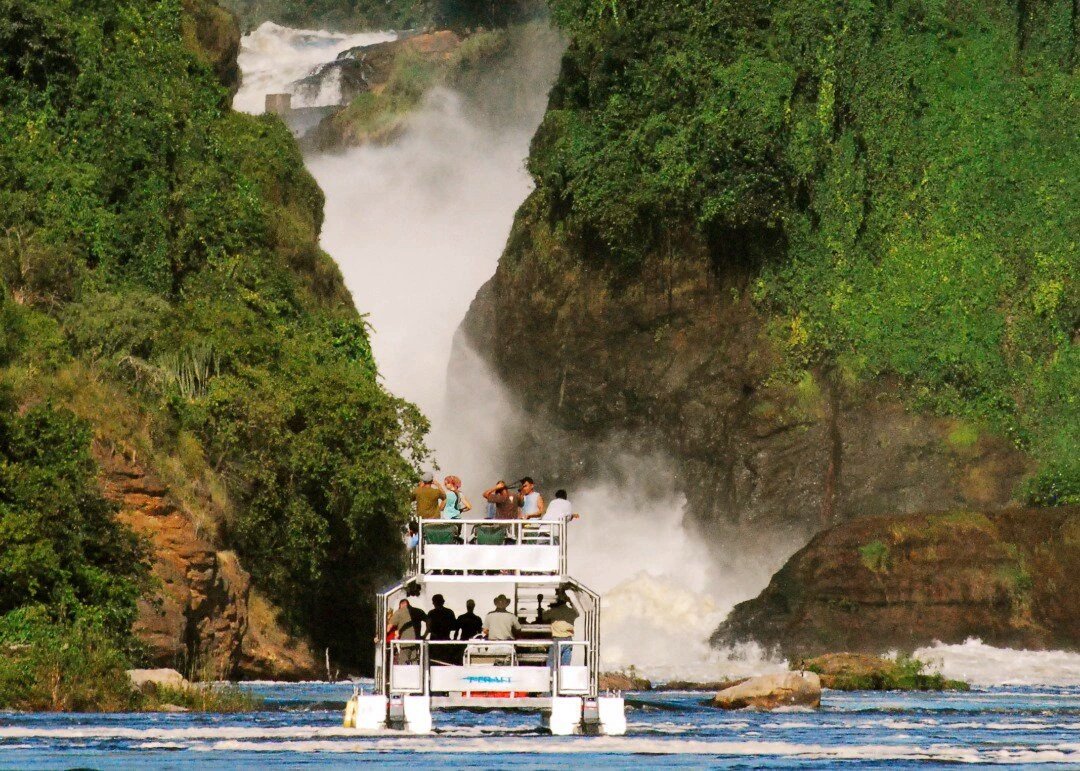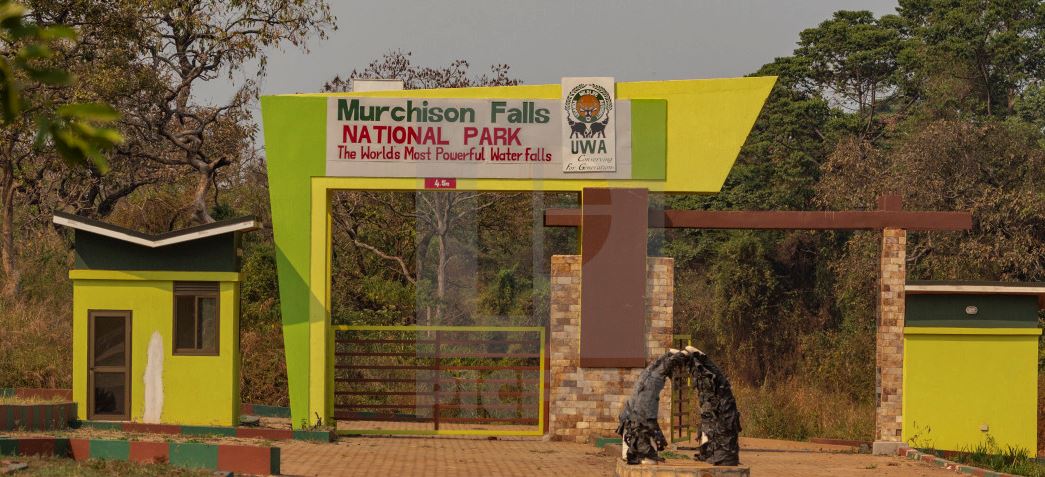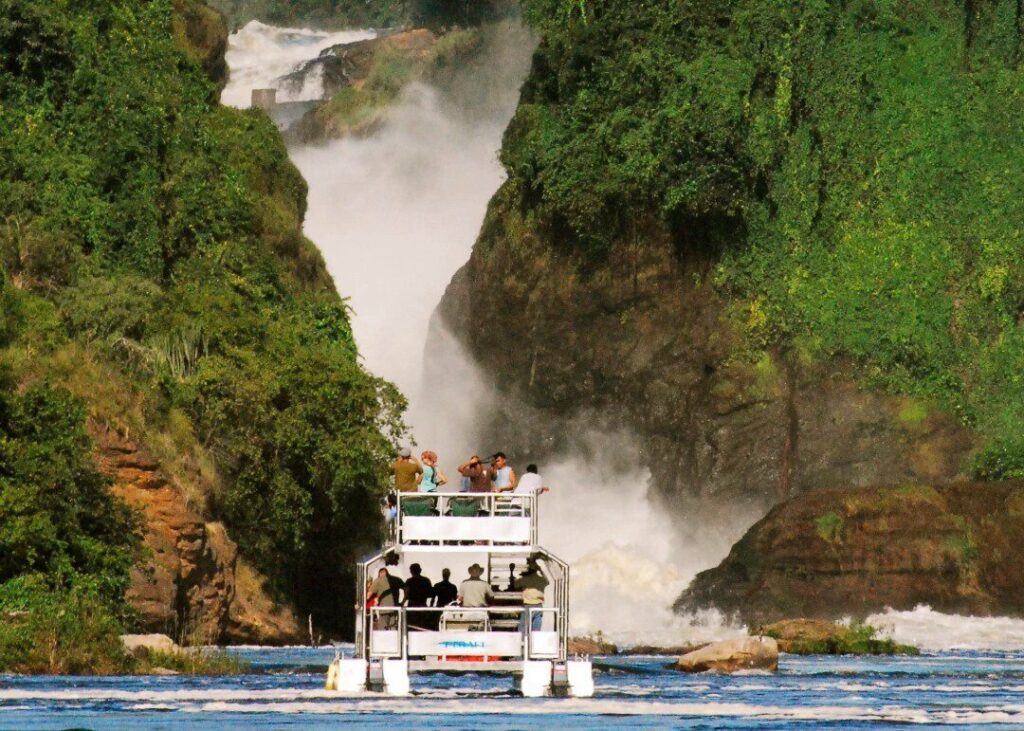Top 10 Interesting Murchison Falls Facts You Didn’t Know
Discover fascinating Murchison Falls Facts— Uganda’s most powerful waterfall, rich in wildlife, adventure, and natural beauty. From its thunderous roar to teeming savannas, this guide uncovers the Murchison Falls facts that make it a must-visit safari gem.
Nestled in the heart of northwestern Uganda, Murchison Falls National Park stands as a testament to the raw power and untamed beauty of Africa. As Uganda’s largest and oldest national park, it spans a vast 3,840 square kilometers of rolling savannas, lush woodlands, and dramatic riverine landscapes, bisected by the mighty Victoria Nile.
Here, the Nile converges into one of the world’s most spectacular waterfalls, where billions of gallons of water crash through a narrow gorge each day. But beyond the falls, Murchison is a haven for wildlife enthusiasts, birdwatchers, and adventurers.
These Murchison Falls facts reveal why it’s a cornerstone of Uganda’s tourism, drawing over 50,000 visitors annually and contributing millions to conservation efforts.
Whether you’re planning a safari or simply curious, dive into the history, ecology, and thrills that define this iconic destination.

Fascinating Murchison Falls Facts
Murchison Falls National Park isn’t just a scenic backdrop—it’s a living encyclopedia of natural wonders. Below, explore key Murchison Falls facts, each highlighting the park’s unique allure. These insights, drawn from historical records and recent surveys, showcase why it’s a top spot for Uganda safaris.
1. Murchison Falls Is the Most Powerful Waterfall in the World
At the park’s core lies Murchison Falls, where the Victoria Nile squeezes through a mere 7-meter-wide gorge before plummeting 43 meters into the Devil’s Cauldron below—a churning pool of whitewater and mist.
This spectacle unleashes around 300 cubic meters of water per second, creating a roar that echoes for miles and a spray that soaks everything nearby. The force is so immense it trembles the surrounding cliffs, earning it the title of the world’s most powerful waterfall by volume and velocity.
For context, Murchison Falls height measures 43 meters, but its narrow width amplifies the drama, making it a photographer’s dream.
Visitors often describe the experience as humbling, feeling the earth’s pulse in every thunderous drop. This fact alone draws thrill-seekers, but it’s just the beginning of the park’s hydraulic marvels.
2. It Lies Along the World’s Longest River — the Nile
Murchison Falls marks a pivotal point on the White Nile, the longest river on Earth at over 6,650 kilometers. The Victoria Nile, originating from Lake Victoria, flows northward through the park from Lake Kyoga, carving an 80-kilometer stretch of rapids before the falls. Here, it dramatically shifts westward into Lake Albert, part of the Albertine Rift Valley.
This riverine lifeline not only shapes the landscape but sustains a vibrant ecosystem. Murchison Falls location—305 kilometers north of Kampala—positions it as a gateway to the Nile’s ancient journey, once explored by Roman legions in 61 AD (though debated by historians).
Today, boat cruises along this stretch reveal hippos basking and crocodiles lurking, turning a simple fact into an immersive adventure.
3. It’s Uganda’s Oldest and Largest National Park
Established in 1952 under the British National Parks Act, Murchison Falls National Park holds the distinction as Uganda’s oldest protected area, evolving from the 1926 Bunyoro Game Reserve.
Covering 3,840 square kilometers (about the size of Rhode Island), it’s the largest in the country, encompassing diverse habitats from open acacia savannas to riverine forests.
This vast expanse, part of the 5,366-square-kilometer Murchison Falls Conservation Area (including Bugungu and Karuma Wildlife Reserves), safeguards biodiversity against threats like poaching and climate change.
The oldest national park Uganda boasts isn’t just big—it’s a recovery story: post-civil war poaching decimated populations, but aerial surveys show elephants rebounding from 900 in 2010 to over 1,300 by 2013. Murchison Falls size ensures room for epic game drives, where the horizon stretches endlessly.

4. Murchison Falls National Park Was Once Called Kabalega National Park
History buffs will love this twist: During Idi Amin’s regime in the 1970s, the park was renamed Kabalega Falls National Park to honor Omukama Kabalega, the 19th-century Bunyoro king who fiercely resisted British colonization.
Exiled to the Seychelles, Kabalega became a symbol of resistance, dying in 1923 en route home. Though the change was never legally formalized, it reflected Uganda’s push for African heritage.
Post-Amin in 1979, the name reverted to Murchison Falls, honoring British geologist Sir Roderick Murchison, as named by explorer Samuel Baker in 1864.
This Murchison Falls history underscores the site’s cultural layers, blending colonial echoes with indigenous pride. Today, locals still whisper “Kabalega,” a nod to its dual identity.
5. Winston Churchill and Ernest Hemingway Visited Murchison Falls
Literary and political icons have left their mark here. In 1907, Winston Churchill traversed the Nile on his East African tour, proclaiming the falls “the chief wonder of Northern Uganda” in his book My African Journey.
Nearly five decades later, in 1954, Ernest Hemingway survived a plane crash near the falls while scouting for a story—ironically, after another crash days earlier.
His tale of the “Murchison Falls safari” inspired The Green Hills of Africa. These Murchison Falls Hemingway anecdotes add glamour, turning the park into a chapter of adventure literature. Imagine hiking where Churchill stood, pondering imperial ambitions amid the roar.
6. It’s a Paradise for Wildlife Lovers
Murchison teems with life: 144 mammal species, including four of the Big Five (lions, leopards, elephants, buffaloes—no rhinos yet, though reintroduction efforts are underway).
Spot over 10,000 buffaloes, 35,000 Uganda kobs, and Uganda’s largest Nile crocodile population along the riverbanks. Rothschild’s giraffes—75% of the global population—grace the savannas, their long necks silhouetted against acacias.
Birds? Over 556 species, from the prehistoric shoebill stork to African fish eagles. Murchison Falls animals thrive in this mosaic: elephants trumpet at dawn, lions prowl at dusk.
Recent conservation has doubled herbivore numbers, proving human efforts can heal war-torn wilds. It’s not just a safari—it’s a symphony of survival.
7. The Falls Can Be Viewed by Boat or Hike
Approach the falls dramatically: Launch from Paraa for a two-hour boat cruise, dodging hippo pods and croc eyes before the base’s misty roar. Then, hike a steep 1.5-kilometer trail to the top, where rainbows arc in the spray and the Nile’s fury unfolds.
This combo—boat cruise Murchison Falls followed by hike to the top—offers vertigo-inducing views and a workout. Guides share lore at Baker’s Point, where Samuel Baker first beheld the spectacle in 1864. It’s accessible yet exhilarating, perfect for all fitness levels.
8. Two Major Waterfalls Exist — Murchison and Uhuru Falls
Murchison isn’t alone: Uhuru Falls, its “twin,” emerged in 1962 amid independence floods, when the Nile carved a parallel path just meters away. Named “Uhuru” (Swahili for freedom), it symbolizes Uganda’s birth on October 9, 1962.
Though smaller, Uhuru adds symmetry—view both from the top, their cascades merging in wet seasons. Uhuru Falls Uganda facts reveal a dynamic geology: It vanished and reappeared before, possibly what Baker described. These Murchison Falls twin falls create a dual spectacle, especially post-rains when flows peak.
9. It’s a Major Conservation Area
Managed by the Uganda Wildlife Authority (UWA), Murchison is a frontline in anti-poaching: Over 7 tons of snares seized in three years, and tech like trail cams bolster patrols. Community tourism funds schools and clinics, with 20% of revenues reinvested locally—generating $2 million yearly.
Conservation in Murchison Falls extends to rhinos: A 2005 project aims to revive populations decimated in the 1990s. Amid oil pipeline debates, the park’s resilience shines—lions rebounding to 400 nationwide, with Murchison as a key stronghold. Visiting supports this vital work.
10. Hollywood Once Came to Murchison
In 1951, The African Queen—starring Humphrey Bogart and Katharine Hepburn—was filmed on the Nile and Lake Albert, capturing the park’s wild essence.
Hepburn’s memoirs recount leeches and fevers, but the result immortalized Murchison’s rapids. African Queen movie Uganda ties draw cinephiles, who can trace Bogart’s path on boat safaris. Films shot in Murchison Falls continue to spotlight its cinematic drama, blending reel with real adventure.
Location and Map
Murchison Falls National Park sprawls across districts like Masindi, Nwoya, and Buliisa, 305 kilometers (190 miles) north of Kampala—a 5-6 hour drive via the Kampala-Masindi road. Where is Murchison Falls located?
Precisely at 2°16′N 31°44′E, hugging Lake Albert’s eastern shore. Distance from Kampala to Murchison Falls makes it an easy add-on to gorilla treks.
Fly into Pakuba Airstrip for a 20-minute transfer. Embed a Google Map for visuals: Search “Murchison Falls National Park” to plot routes—roads are paved but dusty in dry seasons.
Wildlife in Murchison Falls National Park
Beyond facts, Murchison’s wildlife steals the show. The Big Five minus rhinos roam: Lions hunt kobs in golden grasses; leopards stalk from acacias; elephants (900+) herd along the Nile; buffaloes thunder in thousands.
Primates include 600 chimpanzees in Budongo Forest, plus monkeys and elusive forest elephants. Murchison Falls National Park animals extend to 144 mammals: Giraffes nibble treetops, hyenas whoop at night, crocs ambush from waters.
Safari in Murchison Falls peaks on dawn drives—spot Rothschild’s giraffes, Uganda’s national symbol. Birds dazzle with 556 species: Shoebills in papyrus swamps, hornbills in woodlands. Conservation has revived herds, making every sighting a victory.
Best Time to Visit Murchison Falls
Timing elevates your trip: Dry seasons (December–February and June–September) offer optimal conditions—short grass aids spotting, roads stay navigable, and falls flow strong without floods.
Best time to visit Murchison Falls National Park? December–February for lush post-rain greenery and newborn wildlife; June–September for bird migrations.
Wet months (March–May, October–November) bring dramatic falls but muddy tracks—ideal for birders as migrants arrive. Avoid peak heat in January–February if sensitive. Year-round appeal persists, but dry spells minimize disruptions.
Activities Around Murchison Falls
Murchison pulses with action: Game drives traverse savannas for lion prides; boat cruises to the falls reveal hippo yawns and eagle dives. Chimpanzee tracking in Budongo Forest—home to 600 habituated troops—mirrors Kibale’s thrill but with easier trails.
Things to do in Murchison Falls include hot air balloon safaris at dawn, casting golden light over herds; guided nature walks spotting orchids and duikers; sport fishing for Nile perch (catch-and-release).
Birdwatching yields shoebills; cultural visits to Boomu Women’s Group showcase crafts. Activities in Murchison Falls National Park blend adrenaline and serenity—hike to Uhuru’s edge or picnic at the Delta.
Where to Stay
Lodging mirrors the park’s diversity: Luxury seekers unwind at Paraa Safari Lodge, with Nile-view suites, infinity pools, and spa treatments overlooking hippo pools ($400–$600/night). Nile Safari Lodge offers thatched elegance and bush breakfasts ($300–$500).
Mid-range gems like Pakuba Safari Lodge blend comfort with river vistas ($150–$250). Budget travelers favor Red Chilli Rest Camp’s eco-bandas and campsites ($40–$80), steps from the Nile.
Accommodation in Murchison Falls includes Murchison River Lodge for family vibes and Fort Murchison for rustic charm. Lodges near Murchison Falls prioritize sustainability—solar power, local hires—enhancing your stay.
FAQ: Murchison Falls Facts
What is Murchison Falls known for?
Its powerful cascade, where the Nile drops 43 meters through a 7-meter gorge, plus diverse wildlife and Nile safaris.
How tall is Murchison Falls?
43 meters (141 feet), with immense volume making it the world’s most powerful by flow.
Where is Murchison Falls located?
Northwestern Uganda, 305 km north of Kampala, along the Victoria Nile near Lake Albert.
Can you swim in Murchison Falls?
No—strong currents and crocodiles make it unsafe; stick to guided boat views.
What animals can be seen in Murchison Falls National Park?
144 mammals like elephants, lions, giraffes, hippos, crocs; 556 birds including shoebills.
Conclusion
Murchison Falls National Park weaves power, history, and life into an unforgettable tapestry. These Murchison Falls facts—from its thundering heights to rebounding herds—highlight a destination where nature reigns supreme. Whether chasing Hemingway’s ghosts or Baker’s falls, Uganda’s crown jewel awaits.
Plan your safari: Contact Us to today to secure your spot! Dont forget to pack binoculars, and let the Nile’s rhythm guide you. In a world of fleeting wonders, Murchison endures.
Book a Safari!
[wpforms id=”28″]
